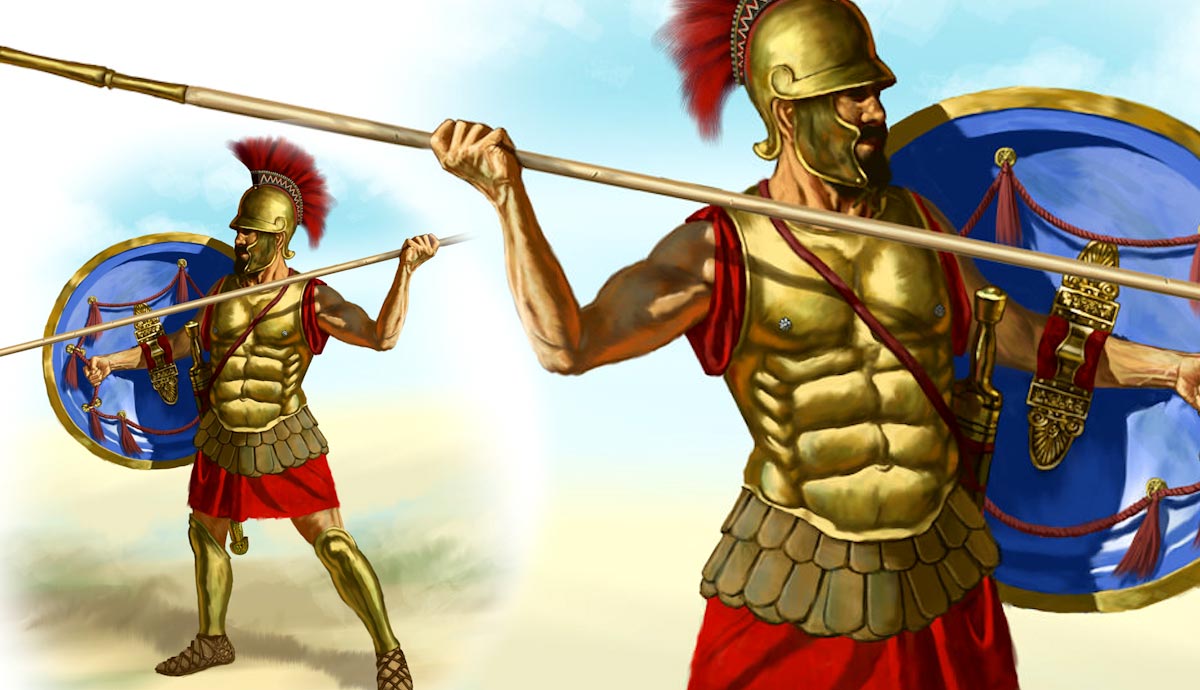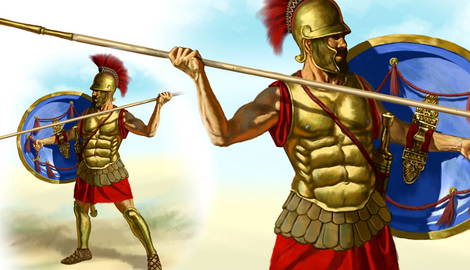
We can define Greek hoplites as the wealthy citizen-soldiers of the ancient Greek city-states, men who were armed with spears and shields. They are famous for the Phalanx (in Greek, line of battle, battle array) formation. Their appearance during the 5th century BCE marked the beginning of a new chapter in the history of the Greek States. The constant stasis of the Greek states ended due to the threat of the Persian empire, and the Greeks had to evolve to survive. Below, we will accompany, in spirit, a hypothetical Athenian Greek hoplite for a full day of warfare.
What were the Greek Hoplites?

The word “Hoplite” comes from “ὅπλον” — hóplon — meaning arms, armor, a weapon. They were military units within the Greek city states’ armies, which were ranked by wealth and mainly composed of peasant farmers prosperous enough to equip themselves as heavy infantry. They won their first battle in the 5th-century BCE, when they defeated the Persian invaders. In Athens, Hoplites were part-timers with little or no formal military training who had to abandon their civilian occupation and present themselves for service whenever the state required. By contrast, Sparta was a militarized state.
Tools of the Hoplite Trade

There was no official uniform or standardized equipment, and the appearance of a hoplite would vary from man to man. The panoply — meaning “all arms” — was expensive. Armor and weapons were almost certainly passed down the family line and replaced only when necessary.
For protection, hoplites wore a bronze helmet (kranos), a pair of bronze shinguards (knimis), and a cuirass, a torso protector made from bronze or even layers of linen glued together. Furthermore, he used a shield (aspis) constructed from wood and sometimes covered with a thin sheet of bronze, on the outer surface and around the rim. He would hold the aspis by the grip (antilabe) found on the shield’s edge.
In combat, a hoplite would use an iron-tipped spear (dory) for killing blows with an overhand or underhand thrust. Due to its length (6 to 9 feet), it served as the first line of attack. It had a leaf-shaped spearhead and a spike at the back which was used if the spearhead broke or if a soldier needed to finish an enemy who’d fallen to the ground.
For close quarters, the hoplite relied on a variety of edged weapons to cut, stab, and slash his adversaries. One example was a double-edged, one-handed sword (xiphos) employed when the dory was unavailable. The classic blade length was generally 20 to 24 inches, although the Spartans supposedly used blades as short as 12 inches during the Greco-Roman Wars.
The Road to War

When they were not fighting, hoplites had normal jobs and occupations the same as other Greek citizens. On discovering he was mobilized, the hoplite would return home and prepare his gear. The mobilization order would usually say how much food was required for the campaign. These provisions included salt, onions, and salt fish. Part of their equipment and food was stored in wagons attended by a personal baggage carrier (skemophoroi), who could be either a slave or a younger relative. Besides food and gear, the skemophoroi would carry bedding and personal kits, gather firewood, forage, and prepare meals.
After reaching the military camp and sleeping, our hoplite would wake and prepare for the Ariston (breakfast). Here, generals discussed the final preparations for the upcoming battle. Besides breakfast, the Greek army also had dinner (deipnon), an evening meal. Battles were fought in the middle of the day after both sides ate their ariston. Some would sip a bit of wine before fighting to calm their nerves.
After breakfast, the army marched out to draw up the line of battle, but old soldiers remained in the camp. The primary military formation was the famous phalanx. Its importance lay in the cohesion of the whole unit. Each man’s survival was dependent upon his comrade’s actions: shields had to overlap, stragglers had to be urged forward, and men needed to protect one another. Yet, for this to function, hoplites also had to be motivated to protect their peers.
The Advance

The advance (ephodos) and charge (epidrome) were the most significant moments of the battle. Like other experienced soldiers, our hoplite would stay in front of others, and they had to keep the formation in check. It is important to note that the Phalanx could be deployed only on plains because crossing water would disrupt the battle formation. The Spartans initiated the custom of singing a war song (paean) as they marched forward, a habit eventually adopted by most Greek soldiers. Singing helped men cope with the desperate feeling of vulnerability as the shock of collision with the enemy approached.
Thucydides recorded how an advancing phalanx tended to drift to the right since “fear makes every man want to do his best to find protection for his unarmed side in the shield of the man next to him on the right, thinking that the more closely the shields are locked together, the safer he will be.”
The general had to give the order at the right time. If he did it too late, there was no momentum, and if he was too early, the formation would end up in disarray and lose energy and cohesion. After the signal, at a certain distance from the enemy, the hoplites would break into a run, charging forward while emitting a high-pitched war cry (“eleleu,” according to Aristophanes).
Fighting: Ancient Greek Edition

Our hoplite and his brothers-in-arms clashed with the enemy and their phalanx. Shield to shield, the hoplites in the front ranks began thrusting with their spears through the gaps in the enemy shield wall. Those in the rear ranks supported them by pushing forward those in the front with their shields.
After the initial clash, the fighting itself took place in two phases. During the spear fight (dorastimos), those experienced would target the undefended parts above and below the shield by jabbing rapidly and repeatedly with their spear. Often spears would shatter after the initial clash, forcing the hoplite to turn to his sword, which represents the second phase of the fighting.
Hoplites were motivated to fight for their kin back home. In the army, members of the same parish served in the same company. Specifically, there were many fathers and sons or nephews and uncles in a unit. Abandoning the battle meant shame, and if a soldier deserted, he would be reminded of it by all of his relatives or neighbors all his life.

At some point in this struggle, one part of a phalanx would collapse under the pressure of the attack. If an army broke, not everyone ran. An example worthy of mentioning is the case of Socrates at the Battle of Delion. After the phalanx broke, he gathered the remaining troops, organized a steady retreat, and saved the life of Alcibiades.
The results of a broken army could be devastating. Routing troops were, in many cases, slaughtered by the enemy. As a result, the casualties were disproportionately large. In Athens, fleeing troops were called “shield-flingers” (rhipsaspis) because they usually threw first their shield, and then their weapons to escape quickly. If our hoplite and his army won the battle, they still had to keep formation and chase the enemy, who might have been successful on the other side of the battlefield.
The Aftermath of the Battle for the Greek Hoplite

Statistically, the casualties on the winning side were typically around five percent, including a relatively high percentage of the hoplites in the front lines — the men actively engaged in the fighting. On the losing side, casualties would probably mount to around 15 percent of the soldiers on the field.
After our hoplite won the battle and returned from the pursuit, two things happened. The wounded were taken care of, and the dead gathered. After, the winning side stripped the enemy bodies of armor, weapons, and jewelry. Loot was pooled, and generals dedicated a tenth of the loot to a particular god for victory. The rest was auctioned off to raise money for the state or divided among the troops.
Memorials of the battle (created from the gear of the defeated) were raised in key locations on the battlefield, like where the army turned the tide in their favor. The defeated city-state would send a herald to break a truce to bury the dead. Traditionally, this was a symbolic admission of defeat.










